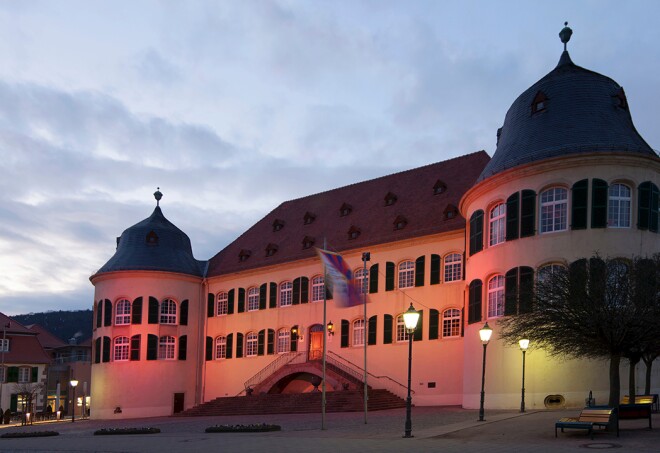The Must-See Sights on the German Wine Route
The oldest of its kind in the world, the German Wine Route takes visitors right through the heart of the scenic Palatinate Forest and wine-growing region. The road begins in Bockenheim, specifically at the House of the German Wine Route, and ends at the German Wine Gate in Schweigen-Rechtenbach, right on the border with France. Along its 50-plus miles lie a slew of historic sights (including castles), picturesque forests and valleys, and, of course, vineyards. While most people opt to drive the route, you can also hike or bike it thanks to a network of dedicated trails.
Highlights
Königstraße 61, 76887 Bad Bergzabern, Germany
Constructed between 1720 and 1725 on the site of a 12th-century fort, this castle once served as the residence of the dukes of Pfalz-Zweibrücken. Attacked, burned down, and destroyed innumerable times over the centuries, it was restored in the 1980s and today houses Bad Bergzabern’s local government offices. It also offers some interesting architecture to explore, from its distinctive round towers to its polygonal staircase turret in the courtyard. Equally compelling is the town of Bad Bergzabern itself, which features half-timbered houses from the 17th and 18th centuries and a striking guesthouse with a Renaissance facade that dates back to 1579.
Sankt-Michaels-Allee 1, 67098 Bad Dürkheim, Germany
Built in 1934 from a couple hundred pine boards, the Dürkheimer Fass is the world’s largest wine barrel, and often described as the heart of the German Wine Route. Constructed by barrel maker and vintner Fritz Keller, it could feasibly hold 449,092 gallons of wine, but has never actually contained any liquid. Instead, it functions as a unique wine bar and restaurant, conveniently located on Bad Dürkheim’s main square.
Surrounded by vineyards, the small town of Bad Dürkheim is of course famous for wine, but it’s also known for its annual sausage festival, which takes place over two long weekends in September and is said to be the largest wine-related festival in the world. Additionally, the “Bad” in the town’s name indicates local wellness facilities, including thermal baths, a spa park, and the old Kurhaus, a former sanatorium that now houses a hotel. If you’re feeling energetic, you can hike up to Limburg Monastery, which was built in the 11th century and today hosts concerts and theater performances.
Surrounded by vineyards, the small town of Bad Dürkheim is of course famous for wine, but it’s also known for its annual sausage festival, which takes place over two long weekends in September and is said to be the largest wine-related festival in the world. Additionally, the “Bad” in the town’s name indicates local wellness facilities, including thermal baths, a spa park, and the old Kurhaus, a former sanatorium that now houses a hotel. If you’re feeling energetic, you can hike up to Limburg Monastery, which was built in the 11th century and today hosts concerts and theater performances.
Augustinergasse 1, 76829 Landau in der Pfalz, Germany
The picturesque village of Landau, located halfway between the German town of Speyer and the French town of Wissembourg, makes for a great stop along the Wine Route, especially to see the Church of the Holy Cross. A former monastery for Augustinian monks, it was built in the early 14th century but expanded throughout the centuries to include a three-aisled Gothic basilica and several attractive Baroque elements. When you’re done touring the church, head to Landau’s medieval city center, where you’ll find traditional taverns, charming cafés, some excellent restaurants, and several great boutiques.
Deutsches Weintor eG,, An der Ahlmühle 1, 76831 Ilbesheim bei Landau in der Pfalz, Germany
Located in Schweigen-Rechtenbach, the German Wine Gate has marked the southern point of the Wine Route since 1936. It was actually built two years earlier, however, and placed along the Wine Route itself to help draw visitors after the plummeting wine prices of the prewar years. Today, the imposing sandstone structure continues to function mainly as a tourist attraction, with a popular on-site restaurant and surrounding vineyards that offer memorable views across the Black Forest and the Vosges Mountains.
Schlossgasse 29, 67157 Wachenheim an der Weinstraße, Germany
Although it has just 4,800 inhabitants, the town of Wachenheim is quite well known, both for its vineyards and its castle. Thought to be built in the 12th century by King Konrad von Hohenstaufen, Castle Wachtenburg is popular mostly for its tremendous views over the surrounding Rhineland, which earned it the nickname “Balcony of the Palatinate.” It’s much larger up close than it looks from down the hill, and also has a preserved tower, wall sections that date from its 12th century beginnings, and the remains of a historic palace. Look around, then head to the on-site café, which serves as a location for various events and wine festivals.














